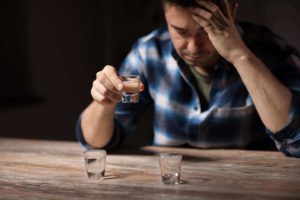In popular culture, we have an image of what an alcoholic is supposed to look like: someone who reaches for the bottle immediately after waking up and remains drunk throughout most of the day. While some people struggling with alcohol addiction fit this mold, addiction shows up in many different ways. We should never judge someone’s struggle based on whether they fit an outdated stereotype.
In reality, alcoholism also known as alcohol use disorder can take many different forms, some easy to spot and others more subtle. Below we’ve broken down some of the most common signs of alcohol use disorder, although it’s important to remember that everyone’s addiction experience is unique.
Forms of Alcoholism & Signs of Addiction
Binge Drinking
Not every individual who struggles with their alcohol use drinks every day. In many cases, they are more likely to binge drink or consume high amounts of alcohol in a short amount of time. The National Institute on Alcohol Abuse and Addiction, or NIAAA, indicates that binge drinkers typically consume 5 drinks in 2 hours for men and 4 drinks in 2 hours for women.
Binge drinking habits are common among the general public. Statistics show that 15% of American adults consume more than 4 drinks in a single sitting between 1 and 11 times per year. Binge drinking is particularly popular among young adult drinkers, but Americans of all ages binge drink on a regular basis.
While binge drinking can lead to health risks such as alcohol poisoning, individuals who drink heavy amounts of alcohol in short periods of time may also be at higher risk for an alcohol use disorder, especially if they have other risk factors. Research from NIAAA found that individuals with additional risk factors for alcoholism (including family members who had struggled with addiction, as well as challenges with impulse control) who engaged in binge drinking drank more heavily than others, putting themselves at a higher risk for developing a long-term addiction to alcohol.
Inability to Stop Drinking
 In some cases, individuals may try to control or cut back on their drinking but may be unable to stop drinking altogether. Even when their drinking is causing problems in their lives and they want to stop consuming alcohol, individuals who are struggling with alcohol addiction may be unable to stop their alcohol use. Some people with an alcohol use disorder may attempt to hide their drinking or only drink socially at parties or family gatherings as a way to avoid signs of addiction. But no matter how often they drink, if their behavior is disrupting their lives, they may be struggling with addiction and can use help and support.
In some cases, individuals may try to control or cut back on their drinking but may be unable to stop drinking altogether. Even when their drinking is causing problems in their lives and they want to stop consuming alcohol, individuals who are struggling with alcohol addiction may be unable to stop their alcohol use. Some people with an alcohol use disorder may attempt to hide their drinking or only drink socially at parties or family gatherings as a way to avoid signs of addiction. But no matter how often they drink, if their behavior is disrupting their lives, they may be struggling with addiction and can use help and support.
Please encourage your loved one to seek support from a medical or addiction treatment professional as soon as possible if their inability to stop drinking (no matter how often they drink) has:
- Caused them to lose their job
- Led to estrangement from family and friends
- Resulted in an accident or injury
- Triggered mental health issues, including depression, anxiety, or anger
Choosing to Drink Due to Cravings
Cravings are powerful physical and mental urges to use an addictive substance after a period of not using. Typically, alcohol cravings involve “triggers,” or places, people, events, and feelings that are associated with alcohol use. While an individual who is trying to manage their alcohol use may be able to abstain at home, they may give into cravings when out with friends, for example.
Some typical craving triggers include:
- Spending time with friends or family members who encourage drinking
- Visiting places where drinking is common
- A moment during the day that is associated with drinking (a “5 pm drink”)
- Seeing physical objects associated with drinking, such as empty bottles or supplies
- Experiencing an emotion that was previously managed through alcohol (such as anxiety, stress, or fear)
Individuals who are struggling with addiction-related triggers can find more information and best practices from NIAAA. Triggers are often difficult to manage without professional support or at least support from a 12-step group like Alcoholics Anonymous (AA).
Drinking and Taking Risks
 Individuals struggling with their alcohol use may not drink every day, but when they do drink, they may consume enough alcohol that they engage in risky, reckless, or life-threatening behavior. Statistics support this: approximately 40% of fatal car accidents involve alcohol use, alongside 60% of fatal burnings and drownings.
Individuals struggling with their alcohol use may not drink every day, but when they do drink, they may consume enough alcohol that they engage in risky, reckless, or life-threatening behavior. Statistics support this: approximately 40% of fatal car accidents involve alcohol use, alongside 60% of fatal burnings and drownings.
These behaviors can include:
- Driving while intoxicated
- Swimming under the influence of alcohol
- Engaging in unprotected sex
- Consuming other addictive substances alongside alcohol
- Cooking or handling flammable materials while intoxicated
- Drinking until “blackout”
While these behaviors can be life-threatening for the drinker, they can also put others’ lives at risk, too. If you or a loved one regularly engage in dangerous and risk-taking behavior while drinking, please seek professional support for your recovery as soon as possible.
Dry Drunks
In some cases, people struggling with alcohol use disorder may not drink at all. In these situations, they are often nicknamed “dry drunks”. Many of the same problem behaviors that occurred when they were drinking are still present even after they get sober. These can include:
- Anger and resentment towards loved ones who are concerned about their health
- Frustration at their life circumstances
- Stress, anxiety, and depression
- Unwillingness to seek further treatment and support
These challenging feelings and emotions don’t go away the instant that an individual gets sober. In many cases, in fact, they may feel stronger without the self-medicating nature of alcohol. Individuals who are in recovery must now deal with the consequences of their addiction, as well as the frustrations of an everyday sober life. In many cases, they must also reckon with the toll that their addiction has taken on their lives, from isolation to anger to challenges at work and at home.
Luckily, for someone experiencing “dry drunk” symptoms, as well as any of the common behaviors listed in this article help is available.
Choosing a reputable and licensed addiction treatment provider can help individuals showing signs of an alcohol use disorder better understand, manage, and overcome their addiction. Through a combination of therapeutic methods, peer support, and candid discussions, treatment providers are able to help individuals find a sustainable and long-term recovery.
If you or a loved one are considering treatment for alcohol use disorder, contact our team at BlueCrest Recovery to learn more about our program and how we can help you move forward.














